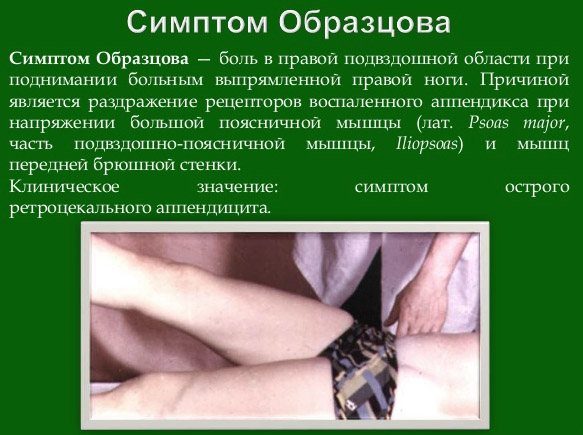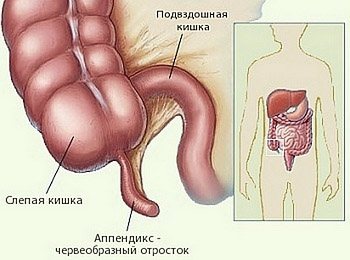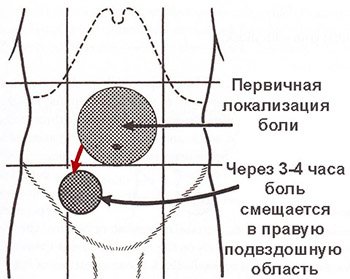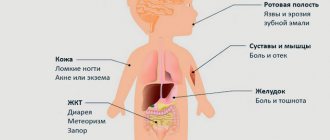Many people are interested in the question: at what age can appendicitis occur, both in children and adults? Inflammation of the appendix - or appendicitis - is one of the most unpredictable and dangerous problems that can happen to internal organs.
The symptoms of appendicitis can be easily ignored - and the moment can be missed, which can, in the worst case, even lead to death. Many people mistakenly believe that this pathology is characteristic only of adults - but this is not so.
Even at a young age, it can affect a person, so you need to be especially careful with it. Let’s figure out at what age a person can, in principle, have acute appendicitis, but first we’ll look at this problem in more detail.
What is appendicitis
Every person, already at birth, has a small appendage of the cecum, located near the junction of the small and large intestines. It's called the appendix and is usually about a centimeter in diameter and about five centimeters long. In its normal state, the appendix helps the body fight infection and generally helps the immune system.
Unfortunately, it may happen that this appendix can become very inflamed - then appendicitis will begin. The exact cause of this problem is still not fully known, but the most common version is a malnutrition of the mucous membrane of this appendix, which allows bacteria to penetrate the walls of the appendix.
However, the exact mechanism why this happens remains to be determined, because under equal conditions this pathology manifests itself only in a small number of people.
Signs of appendicitis in children with an abnormally located appendix
With an abnormal location of the appendix in children, appendicitis has some features:
- If the appendix is located behind the cecum, abdominal pain is not so severe. During palpation, muscle tissue tension is almost not felt. Pain is felt in the groin and in the right side of the lower back. Discomfort may also be felt in the area where the ureters are located. In this case, urination becomes more frequent and causes pain.
- When the appendix is located retroperitoneally, moderate pain is observed in the abdominal area. In this case, discomfort is also felt in the groin, lower back and ureters.
- With the pelvic location of the process, there is no muscle tension or it is very weakly expressed; pain is felt in the lower abdomen and above the pubis, sometimes felt in the perineum. In this case, urination is impaired, stool becomes liquid with mucous impurities.
- When the appendix is localized under the liver, pain is felt in the area of the right hypochondrium. In this same place, muscle tension is clearly felt.
- With the reverse arrangement of the organs, the appendix may be localized on the left. In this case, pain appears on the left side of the abdomen.
At what age can appendicitis occur?
Now let’s figure out how old a child can be for appendicitis to develop. Technically, he could be any age. Even infants have a chance of getting it, but it is so minimal that it almost never manifests itself. The reason why infants are protected from this is the poor development of lymphatic follicles in the appendix. It is this that almost negates the whole problem.
But from three years of age, the chances of this disease manifesting itself can be quite real. It all depends on the structural features of the child’s appendix. Parents should pay close attention to various types of symptoms, which may clearly indicate that a child from three years of age (or even earlier) may have appendicitis.
Appendicitis classification
Inflammation of appendicitis in children can have varying degrees of severity and vary depending on the characteristics of the destructive processes. Therefore, the following types of appendicitis are distinguished:
- Simple, or catarrhal, appendicitis is an uncomplicated form of the disease, which is characterized by slight thickening of the walls of the appendix and slight inflammation.
- Destructive appendicitis can be phlegmonous, in which the appendix increases in size and thrombosis of the vessels of its walls develops, and gangrenous, accompanied by tissue necrosis.
- Empyema - this condition is characterized by the development of an acute purulent process in the appendix.
The destructive form of appendicitis and empyema can lead to rupture of the appendix. However, this does not always happen - in childhood, the integrity of the appendix is often preserved. Sometimes there are cases of complete recovery or transformation of inflammation into a chronic form.
Symptoms of appendicitis in a child
First of all, if a child is very young, his behavior will change. He will sleep worse and become much more whiny. The problem is that if an adult feels which part of his stomach hurts, then the child will simply feel that his whole stomach hurts, and the symptoms will be somewhat similar to food poisoning.
Therefore, it is necessary to carefully monitor any warning signs. In particular, if the temperature has risen very high, there is vomiting and dehydration, then this is a signal that it is necessary to urgently arrange hospitalization and consult a doctor regarding the next steps.
It is also worth paying attention to when the child curls up and, screaming, lies on his left side. As you grow older, the painful sensation becomes more and more specific, with a shift to the right. Then it’s even easier to determine. You can ask your child what pain he feels. It should be constant, without contractions, not pulsating.
Inflammation of appendicitis in children: symptoms and signs
The first symptoms and signs of appendicitis in children are as follows:
- Usually the vermiform appendix becomes inflamed quite acutely. The child experiences severe pain, and he cannot estimate the exact time of its onset.
- The first symptom of appendicitis is usually pain above the navel. After which it begins to be localized in the lower abdomen on the right, although sometimes there are exceptions.
- Painful sensations are heterogeneous. Sometimes dull and aching pain is observed, while in other cases unbearable sensations arise. The discomfort is constant and increases during movement. It can also intensify if the baby lies on his left side.
- The inflammatory process is often accompanied by general weakness, nausea and vomiting. Such symptoms of appendicitis in children are observed in 75% of cases.
- The child's temperature may rise slightly - this indicates the development of inflammation. Usually this figure does not exceed 37-38 degrees. But sometimes it is 39 degrees.
- Usually the child does not have problems with bowel movements. But in rare situations, there is stool retention.
- The intensity and localization of pain during inflammation of the appendix directly depends on the location of the appendix.
- Sometimes the pain decreases when changing body position, especially if you turn the child on the other side.
How is appendicitis diagnosed in children and adolescents?
If any of these symptoms of appendicitis appear in children, you should immediately consult a doctor. It is very dangerous to self-medicate, because the use of painkillers can disrupt the clinical picture, which will create difficulties when diagnosing appendicitis.
Using laxatives or enemas will increase pressure on the inflamed appendix, which can cause it to rupture. Warm compresses will accelerate the development of inflammation and cause purulent formations. That is why the first signs of appendicitis in children and adolescents should be a reason to visit a doctor.
To identify inflammation of appendicitis in children, the following activities and studies are carried out:
- Examination, medical history.
- General urine analysis.
- Detailed blood test.
- Ultrasonography.
- X-ray of the abdominal cavity.
In teenage girls, the signs of appendicitis resemble the symptoms of ovarian inflammation, so they require additional consultation with a gynecologist. In addition, this disorder must be differentiated from the following diseases:
- acute respiratory viral infections;
- pathologies of the digestive tract;
- urological disorders;
- pneumonia;
- measles;
- scarlet fever;
- otitis;
- hepatitis;
- chicken pox;
- intussusception.
Respiratory diseases in a child may be accompanied by abdominal pain, fever, and vomiting. However, in addition to this, they cause nasal discharge, signs of conjunctivitis, and changes in the pharynx, which is never observed with appendicitis.
Inflammation of the lungs can also cause abdominal pain, similar to inflammation of the appendix. In this case, it is worth observing the dynamics of the process. Pneumonia is characterized by increasing shortness of breath and cyanosis of the nasolabial triangle. Moist rales occur under the lungs and breathing becomes weakened - such symptoms are absent with appendicitis. To confirm the diagnosis, an x-ray is performed to detect pneumonia.
Otitis in young children sometimes resembles the signs and symptoms of appendicitis. Usually the child's sleep is disturbed and there is increased anxiety. However, with otitis media there is no abdominal pain or muscle tension.
Stages of the disease
If we divide the course of pathology into stages, we can distinguish the following stages:
- Appendicitis with an uncomplicated course.
- Development of the inflammatory process.
- Acute inflammation of the organ.
The decision to choose treatment tactics depends on the stage at which the patient’s disease is.
In the first stage, conservative treatment is possible. This partially applies to the second stage. In the latter case, surgical intervention is performed, since the risk of severe complications increases greatly, and the problem can cause death. Below we will look at how each stage manifests itself.
Symptoms in uncomplicated cases
The clinical picture in a 10-year-old child with a simple form of the disease is rather weak. Many parents confuse the onset of pathology with a digestive disorder. Initially, the child has pain in the central part of the abdomen, and later pain in the right side. In the early stages, the pain is dull and occurs periodically, but gradually these sensations intensify. In addition to the above signs, symptoms may be as follows:
- Diarrhea.
- Vomit.
- A slight increase in general body temperature, sometimes up to 38°C.
- Increased urination.
- Dry mouth, thirst.
- Covering the root of the tongue with a white coating.
You might be interested in: What to do if your newborn cannot go to the toilet for a long time
When pressing on the area where the appendix is located, the child experiences increased pain.

A medical examination of appendicitis using instrumental diagnostic methods reveals thickening of the walls of the appendix and slight inflammation.
Development of the inflammatory process
The first stage of the disease lasts about 15-24 hours. After this, the pathology moves into the next phase. Here the scenario can develop according to two scenarios.
Phlegmonous form
Symptoms for this form of appendicitis are as follows:
- Severe pain in the navel area, right and below.
- Tension on the right side of the abdominal region upon palpation.
- Temperature rises to 38°C, rarely higher.
- The tongue is covered with a whitish coating.
The vermiform appendix begins to fill with purulent contents, and ulcers form on the outside of the organ. Diagnosing the disease in this form is quite simple.
Gangrenous course
This form of pathology can arise both as a complication of a phlegmonous course, and as an independent disease. This form of the disease is characterized by the process of necrosis of the tissues of the appendix and the destruction of its nerve endings.
1246847579

The patient's pain decreases, but when pressing on the appendix area it increases tenfold. In addition, there is bloating, vomiting, headache, nausea and other signs of intoxication.
Signs of acute organ inflammation
If the pathology is not diagnosed in a timely manner, the child may develop acute inflammation of the appendix. The clinical picture has the following features:
- Unbearable acute pain.
- Rapid heartbeat, increased pulse.
- Repeated vomiting.
- Severe bloating and abdominal tension.
- The tongue is dry and completely covered with a white coating.
Sometimes after a few days the manifestations of the disease decrease, and appendicitis becomes chronic. In this case, further intoxication of the body occurs.
Diseases in young children
Up to 3 years of age, the disease is rare. The vermiform appendix is wide and short, so intestinal contents do not stay there for a long time, and the risk of blockage is minimal. Eating breast milk or ground porridge, soups has a positive effect on motor skills and ensures normal microflora. The lymph nodes of the appendix are underdeveloped and cannot cause obstruction. Congenital anomalies of the gastrointestinal tract can provoke the disease at this age.

Signs of appendicitis in infants are difficult to recognize; the disease manifests itself atypically, so you need to be attentive to any changes. You should be wary of:
1. Crying, screaming of a child, poor sleep, anxiety. Thus, the baby exhibits pain syndrome. Symptoms of appendicitis intensify when feeding, changing clothes, or when the position of the body changes.
2. Children choose a position that brings them relief.
3. Refusal to eat, decreased appetite.
4. Vomiting can reach 4-5 times, does not bring relief.
5. Loose stools, pain when urinating. The child grimaces when he wants to go to the toilet.
6. The temperature often rises to 40 °C.
General symptoms
Acute or chronic appendicitis always manifests itself with pain, the localization of which depends on the location of the appendix. Only in 40% of cases is it in a typical location, and it can be clearly determined that the right iliac region hurts.
- Sometimes unpleasant sensations are observed in the lower back or groin. This is the retrocecal localization of the process.
- With pelvic placement, the pain radiates down the abdomen.
- The appendix can reach the right hypochondrium, in which case the symptoms resemble cholecystitis.
A characteristic feature is the movement of pain. At first, the child may point to the navel area, this indicates the initial stage of the disease, but if the right iliac region hurts, then the condition progresses and immediate medical intervention is required. This symptom of appendicitis in children 3-5 years old is difficult to identify, since they cannot clearly determine where the discomfort is more pronounced; they always point to the navel.

The digestive organ is affected, so signs of appendicitis include nausea and vomiting, which does not bring relief. At an older age it is often once, at a younger age it reaches 5-6 times a day. Stool disorders can be either diarrhea or constipation. For older people, as for adults, delayed bowel movements are typical; in infants, this is loose stool.
The increase in temperature depends on the severity of the disease, the spread of inflammation and the state of the body's immune system. In the initial stages, these are subfebrile indicators; in purulent, gangrenous forms, the temperature reaches 40 °C.
These symptoms indicate appendicitis, they should alert parents and force them to call an ambulance. After all, the deterioration of the condition in children occurs very quickly; the sooner the operation is performed, the better the prognosis for recovery.
Diagnostics
The doctor first of all focuses on complaints, conducts an examination, and then refers for additional laboratory and instrumental examination.
How to recognize appendicitis? To do this, the doctor uses a certain scheme in order not to miss the disease:
1. Complaints: pain in the abdomen, near the navel or in the right iliac region, nausea, vomiting, stool disorders, rise in temperature.
2. Objective examination: tongue coated with white coating, forced position on the side with legs adducted, pain intensifies when changing position.
3. Tension of the abdominal muscles, sometimes it is board-shaped, sharply painful on palpation. False muscle tension may be observed as a defensive reaction, the result of fear. In this case, repeat the procedure when the child falls asleep. If the cause is inflammation, the stomach will be hard even in sleep.
4. Checking specific signs. If you sharply press and then release in the right iliac region, the pain will intensify (this is the Shchotkin-Blumberg symptom). If you lie on your left side, the discomfort will become stronger on the right. Pain when trying to bend the right leg at the knee joint indicates acute appendix.
5. A general blood test confirms the presence of an inflammatory reaction. Leukocytes are the first to react, the SOE increases, but these indicators are not always changed. In some cases, leukocytes may be normal or slightly elevated.
6. Urinalysis can reveal red blood cells, white blood cells, and bacteria. The reaction is especially pronounced when the appendix is localized in the pelvis. The inflammatory process spreads to the bladder and ureters, as a result of which the urine changes.
7. For differential diagnosis of appendicitis in adolescents, in particular in girls, a gynecologist is invited to consult.
8. Ultrasound will reveal acute and chronic appendicitis. This method does not involve radiation exposure, is painless, and does not require additional preparation. The following signs will help recognize the disease:
- The wall thickness exceeds 3 mm.
- Increased volume of the appendage.
- Echogenicity increases.
- The inflammatory reaction can spread to the omentum; it will be swollen, with a double contour.
Ultrasound is the optimal method for detecting appendicitis in children. Perhaps not the most informative, but safe.
9. Computed tomography is an additional study to clarify the location and presence of complications, which will facilitate the operation. For younger people this is a large radiation dose and its use is undesirable. For appendicitis in a child 7 years of age or older, the use of CT is permitted after assessing the balance of harm and benefit.

Difficulties in diagnosing appendicitis in newborns
There are often cases when the correct diagnosis of a small child was made late, and the inflamed appendix ruptured. This is due to a number of problems in diagnosing the disease in a newborn: the baby cannot independently show where the pain bothers him. Infants still have weak immunity; the inflammatory process is not localized in the abdominal cavity due to the small size of the omentum.
If there is the slightest difficulty in making a diagnosis, modern medicine uses the laparoscopy method. With its help, the peritoneal organs are examined with a special device - a laparoscope, which is inserted through a puncture of the abdominal wall. If the examination reveals inflammation in the appendix, an operation is performed to remove it. This simple and safe procedure can be performed on babies from the first days of life.










